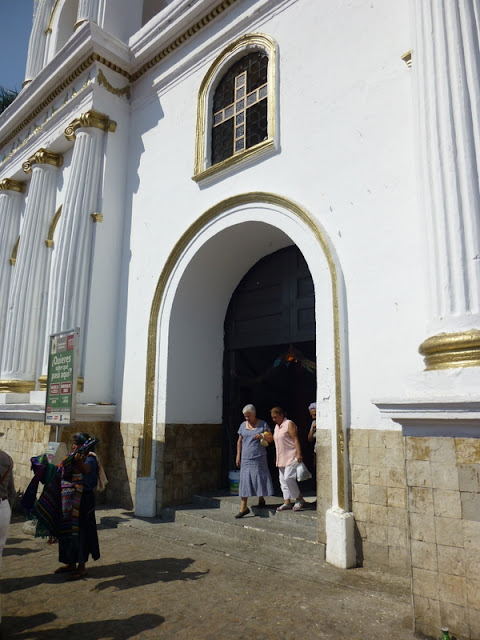We docked at Puerto Chiapas at 7:00am. Puerto Chiapas is a recently-constructed port
and cruise terminal which provides direct access to the Mexican state of
Chiapas. Chiapas is located in the
southwestern portion of Mexico, bordering Guatemala. Prior to the arrival of the Conquistadors in
the early 16th Century, Chiapas was the heartland of the Mayan,
Olmec, and Zoques indigenous pre-Colombian peoples. Some sites, or the earliest known Mayan ones,
are located near Tapachula about 30 miles inland from the port.
Puerto Chiapas Cruise Terminal
Thankfully not
overrun with third class cruise ships and their fourth class passengers.
At 8:30am, it was onto the Tourist Bus for a visit to
Izapa Archeological site and Tapachula.
After a 30 minute drive through the agricultural countryside, which
featured extensive mango orchards, we arrived at Izapa. Those parts of Chiapas State that we toured
do not fit the common perception of arid, desert Mexico. This area is well-watered, sub-tropical
farmland, with small areas of remnant sub-tropical bush and forest. The general perception from the window of a
tour bus is that of a prosperous, agricultural region.
Izapa. Izapa Archeological site was discovered
in 1945 by construction crews building the Pan-American Highway. The Smithsonian Institution was notified and
sent archeologists; and the site, although not famous in the tourist world, has
been actively researched since the 1940s.
Originally occupied by the Mayans from ~600 BCE to ~400 CE, Izapa was a
major commercial center based on chocolate and obsidian trade. There are over 160 identified Mayan structures. Most prominent are mounds (flat-topped
pyramids) thought to house temples and chiefs’ palaces on their summits and a
ball game court at the base.
Izapa, Mayan Stela and Flat-topped Pyramid
Excavated and
restored mound and stela.
Izapa, Partially Excavated Mound
Mounds are thought
to have had structures on their tops where Mayan Chiefs lived.
Izapa, Sacrificial Altar (Foreground)
You could really
lose your heart here!
Izapa, Mayan Ball Game Court
The winning team
got to go to the Sacrificial Altar for heart surgery. No such thing as a winning streak.
The site was abandoned by the Mayans in ~500 CE, but it
was reoccupied about ~900 CE and remained active until the Mayans disappeared
from Mexico and Central America in ~1200 CE.
Olmecs and Zoques then entered, only to be conquered and eaten by the
Aztecs, who were, in turn, conquered (not eaten) by the Spanish. The Aztecs were killed by “Guns, Germs, and
Steel” (apologies to Jared Diamond).
Izapa, Another Sacrificial Altar
Such heavy demands
put on winning ball teams.
We toured Izapa on foot for about two hours and listened
to our guide’s description of the mounds, stela and ball court in the ever-increasing
heat of the day. (The lizards gave up
about half-way through.) Finally, we
were herded back on the bus for the short trip to Tapachula to tour San Agustin
Church, Socnusco Archeological Museum, and Tapachula Town Hall; all of which
were located around the central town plaza.
Tapachula. Our first stop was San Agustin Church,
which was constructed in the 18th Century on the site of the
original Spanish church dating from 1525.
The church is in the neo-classical style, and the façade was constructed
from the original 1525 building. The church’s interior lacks the profuse decoration
of many Catholic churches. Regretfully,
statuary on the walls are largely recently-made, colored plaster-of-paris,
which detract from the 18th Century stark beauty of the whitewashed interior.
Archeological Museum and St. Agustin Church
from Plaza
An open air market
is located in the street between the museum and church.
St. Agustin Church Facade
Part of the original
Spanish Church makes up the facade.
St. Agustin Church, Interior and Altar
This is where plaster
saints come to die!
The Socnusco Archeological Museum is in the former city
hall. The museum’s collections are
largely taken from nearby archeological sites, like Izapa. Exhibits include stela, pottery, and other
small artifacts from Mayan, Olmec, Zoques, and Aztec cultures. They are well displayed and described in both
Spanish and English.
Archeological Museum Entrance Ticket
Museum’s worldwide
now like these giant tickets. (Jaguar
head part of Mayan aqueduct.)
Stela from Nearby Mayan Archeological
Sites.
Sadly, no Mayan calendars. They must have disappeared after the end of the world.
Mayan Burial Pots and Pestals
Where were the
hearts buried?
After walking across the town plaza in the noon-day heat,
we were in front of the new town hall, which is flanked by statues of Mexican national
and local heroes – Hidalgo and Cordova y Drdonez. It is a modern building without any
architectural reason for comment; however, in the interior plaza, there is a
mural depicting local life and two very large, stained-glass windows. One window represents the local natural
environment and the other, peoples of the area. Both the mural and the stained-glass windows
bring to mind the long tradition of mural painting in Mexico.
Tapachula City Hall Fronted by Mexican
Heroes and Flag
By this time, the
plaza was nearly empty except for crazy gringos!
City Hall Interior Stained Glass Windows
Murals in glass.
After cooling off at the expense of the local citizenry’s
tax pesos in the municipal building, it was back on the bus for the 30-minute
return trip to the ship. Four hours had
taken its toll, and the only sound was the soft snoring of our fellow
passengers. Hopefully, they remembered
the tour after they awoke and left the bus at the Puerto Chiapas cruise
terminal.
The rest of the day was largely uneventful. We had lunch, skipped dinner and watched a
movie in our suite.
Sunset Over the Pacific Ocean
Serenity.
















No comments:
Post a Comment